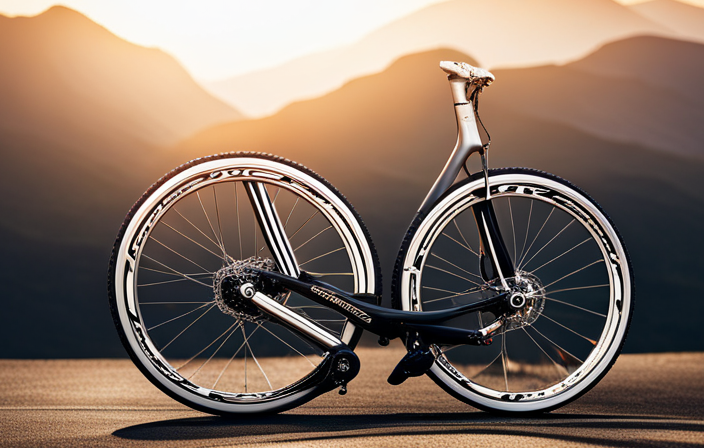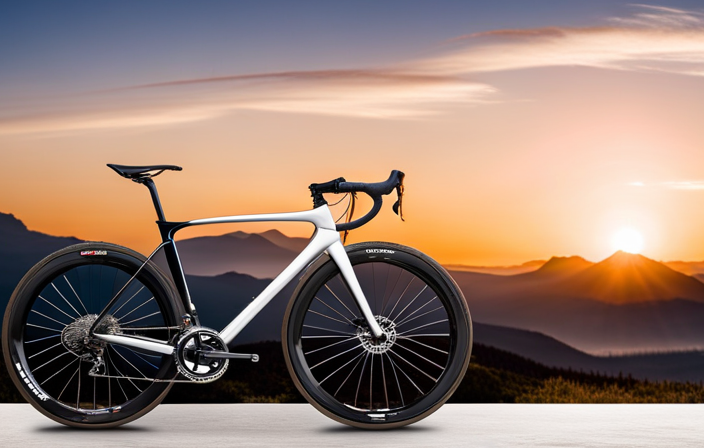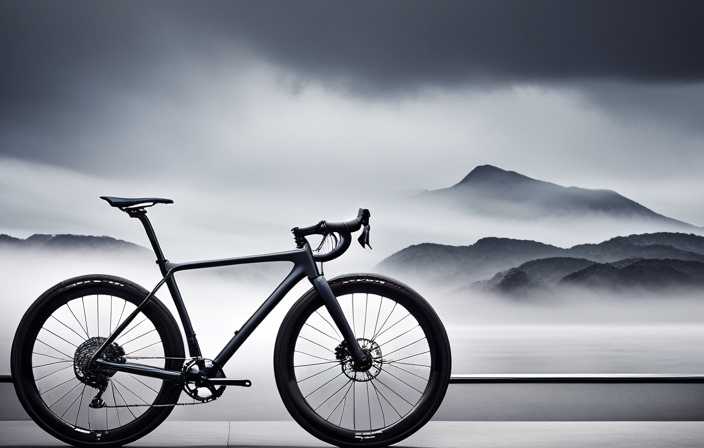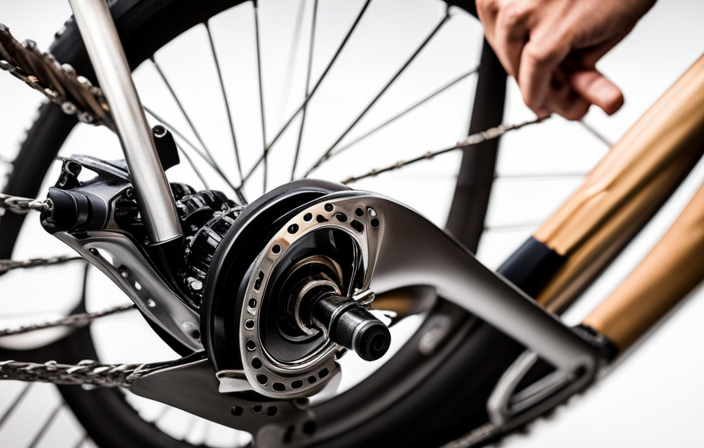Were you aware that selecting the correct size disc brake for your gravel bike could greatly affect your safety and performance when riding on the trails?
With a wide range of options available, it can be overwhelming to determine which size is best suited for your riding style.
In this article, I will provide you with a comprehensive guide to understanding the basics of disc brakes, factors to consider when choosing the size, measuring and determining the right size for your bike, and ensuring compatibility with standards.
So let’s dive in and find out what size disc brake is perfect for your gravel adventures!
Key Takeaways
- Disc brake size for a gravel bike should be chosen based on intended use and personal preferences, taking into account factors like riding style and terrain preference.
- Proper installation and alignment procedures, as well as accurate measurement and maintenance, are important for disc brakes on gravel bikes.
- Common disc brake sizes for gravel bikes include 140mm, 160mm, 180mm, and 203mm, each with its own advantages and considerations.
- When upgrading or replacing disc brakes, it is important to consider compatibility with the frame and components, and hydraulic disc brakes may offer better performance.
Understanding the Basics of Disc Brakes
You’ll need to understand the basics of disc brakes before determining the size for your gravel bike. Disc brakes are a crucial component of any bike, providing reliable stopping power in all weather conditions. Proper maintenance is essential to keep your disc brakes working efficiently and safely. Regular inspection and cleaning of the brake pads, rotors, and calipers will help prevent any issues from arising. Additionally, it’s important to follow proper installation procedures when replacing or upgrading your disc brakes. This includes ensuring that the rotors are properly aligned with the calipers and that all bolts are tightened to the manufacturer’s specifications.
When choosing the size of disc brakes for your gravel bike, there are several factors to consider. The most important factor is the intended use of your bike. If you plan on tackling more technical off-road terrain or carrying heavy loads, larger disc rotors may be necessary to provide sufficient stopping power. However, if you primarily ride on smooth surfaces or prefer a lighter setup, smaller disc rotors may be suitable.
In conclusion, understanding how disc brakes work and performing regular maintenance is crucial for optimal performance and safety. When selecting the appropriate size for your gravel bike, take into account factors such as intended use and personal preferences.
Factors to Consider When Choosing Disc Brake Size
When considering which disc brake to choose for a gravel bike, it’s important to take into account various factors. One of the key factors is the size of the disc brake. The size of the disc brake can have a significant impact on bike handling and performance. Here are some measuring techniques to help you determine the appropriate disc brake size for your gravel bike:
-
Rotor Size: The rotor is the circular metal disc attached to the wheel hub. It comes in different sizes, typically ranging from 140mm to 203mm in diameter. Larger rotors provide more stopping power, making them ideal for riders who frequently ride steep descents or carry heavy loads.
-
Caliper Clearance: The caliper is the part that clamps onto the rotor when braking. You need to ensure that there is enough clearance between the caliper and rotor to avoid any rubbing or interference while riding.
-
Frame and Fork Compatibility: Check if your frame and fork are designed to accommodate larger rotors. Some frames and forks may have limitations on how big of a rotor they can fit, so it’s crucial to check their specifications before choosing a specific disc brake size.
Considering these factors will help you select an appropriate disc brake size that suits your riding style and terrain requirements without compromising bike handling.
Next, we will explore the different disc brake sizes available for gravel bikes without skipping a beat.
Different Disc Brake Sizes Available
When it comes to disc brake sizes for gravel bikes, there are several options available. The most common sizes include 140mm, 160mm, 180mm, and 203mm disc brakes.
Each size offers its own advantages and considerations. For example, smaller sizes like the 140mm and 160mm are lighter and more aerodynamic, making them suitable for riders who prioritize speed and weight savings.
On the other hand, larger sizes like the 180mm and 203mm provide increased stopping power and heat dissipation, which is beneficial for riders who tackle steep descents or carry heavy loads.
Ultimately, choosing the right disc brake size depends on your specific needs and riding style.
140mm Disc Brakes
To determine the appropriate size disc brake for your gravel bike, consider the recommended mm measurements. Here is a step-by-step guide on how to measure and choose the right disc brake size:
- Measure the diameter of your current rotor or consult your bike’s specifications.
- Determine if you need a larger or smaller rotor based on your riding style and terrain.
- Consider the advantages and disadvantages of different sizes. Larger rotors provide more stopping power but may add weight to your bike. Smaller rotors are lighter but may not offer as much stopping power.
- Take into account any compatibility issues with your frame or fork before making a final decision.
With these considerations in mind, you can confidently select the appropriate mm disc brake for your gravel bike.
Moving forward, let’s explore the benefits and drawbacks of different types of mm disc brakes available in the market today.
160mm Disc Brakes
Consider the advantages and disadvantages of various mm disc brakes available in the market today to find the right one for you. When it comes to choosing the size of disc brakes for your gravel bike, two important factors to consider are measuring accuracy and brake pad compatibility. The measuring accuracy refers to how precisely the disc brake size is determined, which can affect its performance and fit on your bike. It is crucial to ensure that the chosen disc brake size aligns with your bike’s specifications for optimal braking power. Additionally, you need to consider brake pad compatibility as different disc brake sizes may require specific brake pads. This ensures proper contact between the pad and rotor, enhancing braking efficiency. By carefully assessing these factors, you can select a suitable mm disc brake that meets your bike’s requirements. Moving forward into our discussion on ‘mm disc brakes,’ we will explore their functionality and application in more detail without repeating information already covered.
180mm Disc Brakes
One important factor to keep in mind is the compatibility of brake pads with different mm disc brakes. When it comes to measuring accuracy, it is crucial to select the correct size disc brake for your gravel bike. Using a brake pad that is not compatible with the specific mm disc brake can lead to improper braking performance and potential safety issues.
Additionally, it is essential to consider the wear of brake pads when choosing the right size disc brake. Over time, brake pads gradually wear down due to friction against the disc brake rotor. Therefore, selecting an appropriate mm disc brake that matches your gravel bike’s needs will help ensure optimal braking efficiency and minimize unnecessary wear on your brake pads.
Transitioning into the subsequent section about ‘mm disc brakes,’ it is important to explore other key aspects such as installation and maintenance considerations.
203mm Disc Brakes
The 140mm disc brakes on your gravel bike are crucial for ensuring optimal braking performance and safety. These disc brakes are designed to provide the necessary stopping power while maintaining a lightweight and compact design. The measuring accuracy of these brakes is essential for achieving precise modulation and control over your bike’s braking system.
When it comes to brake pad compatibility, the 140mm disc brakes offer a wide range of options. You can choose from various brake pad materials such as organic, sintered, or semi-metallic, depending on your riding style and terrain conditions. This versatility allows you to customize your braking experience for maximum efficiency and durability.
Moving forward, let’s discuss the pros and cons of different disc brake sizes in order to determine which option would be most suitable for your specific needs without compromising performance or safety.
Pros and Cons of Different Disc Brake Sizes
When it comes to disc brake sizes for your gravel bike, you’ll want to know the pros and cons of different options. Choosing the right disc brake size for off-road riding is crucial in ensuring optimal performance and safety. Let’s compare the various disc brake sizes commonly available in the market.
| Disc Brake Size (mm) | Pros | Cons |
|---|---|---|
| 140 | Lightweight | Reduced stopping power on steep descents |
| 160 | Balanced performance | Can overheat on long descents |
| 180 | Increased stopping power | Slightly heavier than smaller sizes |
A 140mm disc brake offers a lightweight option that is ideal for riders prioritizing weight savings. However, it may lack sufficient stopping power on steep descents. On the other hand, a 160mm disc brake provides a balanced performance suitable for most off-road conditions. However, it may be prone to overheating during extended downhill rides. If you require increased stopping power, a 180mm disc brake would be a better choice, although it does come with slightly more weight.
To measure and determine the right disc brake size for your gravel bike, several factors need consideration such as your riding style, terrain preference, and body weight distribution. By taking these into account, you can ensure an optimal balance between braking performance and overall bike setup.
Now let’s delve into how to measure and determine the right disc brake size for your gravel bike without compromising its functionality.
How to Measure and Determine the Right Disc Brake Size for Your Gravel Bike
To accurately determine the appropriate disc brake dimension for your off-road adventure, you can measure factors like riding style, terrain preference, and body weight distribution. When it comes to disc brakes on a gravel bike, there are various sizes available to choose from. The two most common sizes are 140mm and 160mm. The size refers to the diameter of the rotor, which is the metal disc that attaches to the wheel hub.
Choosing the right disc brake size is crucial as it directly affects your stopping power and overall performance on different terrains. Generally, larger rotors provide more stopping power and better heat dissipation, making them ideal for riders who tackle steep descents or carry heavier loads. On the other hand, smaller rotors are lighter and offer better modulation for riders who prefer more control over their braking.
If you’re considering upgrading your disc brakes, it’s essential to ensure compatibility with your bike frame and fork. Some gravel bikes may have specific mounting standards or clearance limitations that dictate which size rotor you can use.
Proper disc brake maintenance is also vital for optimal performance and durability. Regularly inspecting and cleaning your rotors and pads can prevent contamination or wear issues that may affect braking efficiency.
Transitioning into the next section about the importance of proper disc brake installation and maintenance, it’s crucial to note that installing brakes correctly ensures they function at their best capacity while minimizing potential safety hazards.
The Importance of Proper Disc Brake Installation and Maintenance
Properly installing and maintaining your brakes is crucial for optimal performance and safety on your off-road adventures. When it comes to disc brake installation, there are a few key steps to follow.
First, ensure that the brake caliper is aligned correctly with the rotor. This will prevent any unnecessary rubbing or dragging.
Next, make sure that the rotor is securely fastened to the hub using the appropriate bolts or lockrings. Loose rotors can lead to poor braking performance and potential accidents.
Disc brake maintenance is equally important in ensuring your brakes function properly over time. Regularly inspecting and cleaning your rotors will help remove any dirt or debris that could affect braking power.
It’s also essential to check the brake pads for wear and replace them when necessary. Additionally, bleeding the brake system periodically will remove any air bubbles that may have entered over time, ensuring consistent and reliable braking.
In summary, proper disc brake installation and maintenance are vital for safe and effective off-road riding. By following these steps, you can enjoy confident stopping power on your gravel bike. Now let’s move on to discussing recommended disc brake sizes for different gravel bike models.
Recommended Disc Brake Sizes for Different Gravel Bike Models
Different models of gravel bikes have recommended sizes for their disc brakes. When it comes to choosing the right size, there are several factors to consider, including measuring techniques and brake pad materials.
To determine the appropriate disc brake size for your gravel bike, you need to measure the rotor diameter accurately. This can be done using a caliper or a tape measure. Most gravel bikes come with disc brakes that range in size from 140mm to 160mm in diameter. Smaller rotors (140mm) provide lighter weight and better heat dissipation, making them suitable for riders who prioritize speed and performance. On the other hand, larger rotors (160mm) offer increased stopping power and improved modulation, making them ideal for riders who frequently encounter steep descents or carry heavy loads on their bikes.
When it comes to brake pad materials, most gravel bike manufacturers recommend using organic or semi-metallic pads. Organic pads provide excellent modulation and low noise levels but wear out faster compared to semi-metallic ones. Semi-metallic pads offer improved durability and heat resistance but may produce more noise under heavy braking.
To ensure optimal braking performance on your gravel bike, it is essential to follow the manufacturer’s recommendations regarding disc brake sizes and pad materials. Upgrading or replacing disc brakes should be done carefully, considering factors such as compatibility with your bike frame and components.
Tips for Upgrading or Replacing Disc Brakes on Your Gravel Bike
When upgrading or replacing your gravel bike’s braking system, there are a few factors to consider. First, make sure to check the compatibility of the new disc brakes with your frame and components. This includes checking the rotor size to ensure alignment and optimal performance.
Consider opting for hydraulic disc brakes, as they offer advantages over mechanical ones. Hydraulic brakes provide better modulation, increased stopping power, and require less maintenance.
To keep your disc brakes in top shape, it’s important to regularly maintain them. This includes inspecting and cleaning your brake pads and rotors, and replacing them when necessary to prevent any loss in braking performance.
If you have hydraulic disc brakes, it’s essential to regularly bleed the system. This process removes any air bubbles and helps maintain consistent braking power.
By following these tips and considering the advantages of hydraulic systems, you can ensure a reliable and efficient braking experience on your gravel bike. In the next section, we will explore common mistakes to avoid when choosing a disc brake size and further considerations for optimizing your bike’s braking performance.
Common Mistakes to Avoid When Choosing Disc Brake Size
One common mistake to avoid is not considering the compatibility of your chosen braking system with your frame and components. It’s important to ensure that the disc brake size you choose is suitable for your gravel bike. Many people mistakenly believe that bigger disc brakes are always better, but this is not necessarily true. While larger rotors can provide more stopping power, they also add weight to your bike and can affect its handling. On the other hand, smaller rotors may not provide enough stopping power for aggressive off-road riding.
To help you make an informed decision, here are some tips for proper disc brake maintenance:
- Regularly inspect your brake pads and replace them if they show signs of wear.
- Keep your rotors clean by using a non-oily cleaner and avoiding contact with oil or grease.
- Check the alignment of your calipers to ensure even pad wear and optimal braking performance.
- Bleed your hydraulic brakes regularly to maintain consistent performance.
Now let’s address some common misconceptions about disc brake size:
| [table] | Misconception | Fact |
|---|---|---|
| Bigger is always better | Disc brake size should be chosen based on individual riding needs and preferences | |
| Larger rotors provide more stopping power | Larger rotors do offer increased stopping power but can negatively impact bike weight and handling | |
| Smaller rotors are always insufficient | Smaller rotors may be sufficient for less aggressive riding styles |
When choosing the right disc brake size for your gravel bike, it’s important to consider factors such as terrain, riding style, and personal preference. Expert recommendations and insights on disc brake sizing will be discussed in the next section.
Transitioning into the subsequent section: Now that we’ve covered some common mistakes to avoid when choosing disc brake size, let’s explore expert recommendations and insights on finding the perfect fit for your gravel bike.
Expert Recommendations and Insights on Disc Brake Sizing
To get the best performance and stopping power for your off-road adventures, experts recommend considering their insights on selecting the ideal disc brake dimensions.
When it comes to measuring techniques, it is crucial to accurately determine the size of your rotor and caliper. This can be done by using a caliper or ruler to measure the diameter of the rotor, which typically ranges from 140mm to 203mm for gravel bikes. Additionally, you should also check the compatibility of your frame and fork with different disc sizes.
Maintenance tips are equally important in ensuring optimal performance. It is essential to regularly inspect your disc brakes for any signs of wear or damage. This includes checking the thickness of the brake pads and replacing them if they are too thin. Furthermore, keeping your rotors clean and free from debris will help maintain consistent braking performance.
Understanding these expert recommendations and following proper maintenance practices will ensure that you choose the right size disc brake for your gravel bike. By doing so, you can maximize both performance and stopping power during your off-road adventures.
Now let’s explore how disc brake size impacts overall performance and stopping power without compromising safety.
How Disc Brake Size Impacts Performance and Stopping Power
The performance and stopping power of your off-road adventures can be greatly influenced by the dimensions of your chosen disc braking system. When it comes to disc brake sizing for gravel bikes, there are a few important factors to consider.
One of the key considerations is the measuring technique used to determine the appropriate size for your bike. The two main measurements that are commonly used are rotor diameter and caliper mounting standard.
Rotor diameter refers to the size of the braking surface on the disc rotor. Larger rotors generally provide more stopping power and better heat dissipation, which can be beneficial for longer descents or heavier riders. On the other hand, smaller rotors are lighter and may offer better modulation, allowing for more precise control in technical terrain.
Another important factor is the caliper mounting standard, which determines how the caliper attaches to the frame or fork. Common standards include post mount and flat mount. Each standard has its own advantages and limitations, so it’s essential to choose a disc brake system that is compatible with your bike’s frame/fork.
It’s worth noting that while larger rotors generally offer better stopping power, they can also impact bike handling by adding weight and affecting maneuverability. Therefore, it’s crucial to find a balance between stopping power and overall bike performance.
In conclusion, choosing an appropriate disc brake size involves careful consideration of both rotor diameter and caliper mounting standard. These factors can have a significant impact on your bike’s handling and overall performance during off-road adventures.
In the next section, we will explore how different disc brake sizes have been tested and compared in real-world scenarios without compromising safety or functionality.
Testing and Comparing Different Disc Brake Sizes
When testing and comparing different sizes of disc brakes, it is important to consider their impact on performance and stopping power. The size of the disc brake plays a crucial role in determining how effectively the bike can slow down or come to a complete stop. Here are five key factors to consider when evaluating disc brake sizes:
-
Disc Brake Modulation: A larger rotor provides better modulation, allowing for precise control over braking power. This is particularly important when riding off-road or on loose surfaces where sudden stops can lead to loss of traction.
-
Stopping Power: Larger disc brakes generally offer more stopping power, which is essential for gravel bikes that often face challenging terrain and require quick deceleration.
-
Heat Dissipation: Bigger rotors have greater surface area, allowing for improved heat dissipation during prolonged braking periods. This reduces the risk of overheating the brake system and ensures consistent performance.
-
Weight Penalty: Larger disc brakes typically weigh more than smaller ones. While this may not be a significant concern for some riders, weight-conscious individuals might prefer smaller rotors to minimize any unnecessary weight gain.
-
Impact on Bike Handling: It’s important to find a balance between optimal stopping power and maintaining agile bike handling characteristics. Overly large disc brakes can impact maneuverability and compromise overall ride quality.
Considering these factors will help ensure safety and performance with the right disc brake size, ultimately enhancing your riding experience on gravel terrains.
Ensuring Safety and Performance with the Right Disc Brake Size
Choosing the correct disc brake dimensions is crucial for ensuring a safe and high-performance riding experience on off-road terrains. When it comes to measuring techniques, there are a few key steps to follow.
First, you need to measure the rotor diameter accurately. This can be done using a caliper or measuring tape, ensuring that you measure from one outer edge of the rotor to the other. Additionally, it’s important to consider the thickness of the rotor when determining the appropriate disc brake size for your gravel bike. This can be measured with a micrometer tool, which allows for precise measurements.
Maintenance tips are also essential in guaranteeing optimal performance and safety with your disc brakes. Regularly inspecting and cleaning your rotors helps prevent any build-up of dirt or debris that could affect braking efficiency. Furthermore, checking and adjusting pad wear is crucial for consistent performance and avoiding potential issues such as brake fade.
Understanding disc brake standards and compatibility is the next step in finding the right disc brake size for your gravel bike without compromising safety or performance. By following these measuring techniques and maintenance tips, you can ensure that your chosen disc brake size meets industry standards and is compatible with your bike’s specific requirements.
Now let’s delve into understanding disc brake standards and compatibility without sacrificing safety or performance.
Understanding Disc Brake Standards and Compatibility
To ensure your safety and optimize performance, it’s important to understand the standards and compatibility of disc brakes for your off-road riding experience. Disc brake compatibility refers to the ability of a disc brake system to work seamlessly with other components on your gravel bike. This includes the rotor size, mounting style, and caliper type. Understanding these factors will help you choose the right disc brake size that is compatible with your bike.
Disc brake standards are set by industry organizations such as the International Organization for Standardization (ISO) and the Post Mount standard. These standards dictate things like rotor diameter, bolt pattern, and mounting interface. By adhering to these standards, manufacturers ensure that their disc brakes can be easily installed and used across different bike models.
To better visualize this information, here is a table outlining some common disc brake standards:
| Standard | Rotor Diameter (mm) | Bolt Pattern |
|---|---|---|
| ISO 6-bolt | 160-203 | 6-bolt |
| Center Lock | 140-203 | Center Lock |
| Post Mount | 140-203 | N/A |
Understanding disc brake compatibility and standards will allow you to make informed decisions when choosing the right size for your gravel bike. With this knowledge in mind, we can now move on to final thoughts and conclusion regarding disc brakes for gravel bikes.
In conclusion, understanding disc brake compatibility and adhering to industry standards is crucial when selecting the right size for your gravel bike.
Final Thoughts and Conclusion
In summary, it is essential to understand disc brake compatibility and adhere to industry standards when selecting the appropriate components for your off-road riding experience.
When considering upgrading options for your gravel bike’s disc brakes, there are a few key points to keep in mind:
-
Rotor size: Opting for larger rotors can provide better heat dissipation and braking power, particularly for riders who tackle steep descents or carry heavy loads. However, it’s important to ensure that your frame and fork can accommodate the larger rotor size.
-
Caliper compatibility: Different caliper mounting standards exist, such as post mount and flat mount. It’s crucial to choose a caliper that is compatible with your frame and fork.
-
Brake pad options: Consider experimenting with different brake pad compounds to find the ones that offer optimal performance for your specific riding conditions. Some pads may provide better modulation or durability depending on factors like weather and terrain.
When it comes to maintenance tips, regular inspection of your disc brakes is key. Check for wear on brake pads and rotors and replace them when necessary. Additionally, keeping the braking system clean by removing any dirt or debris will help maintain consistent performance.
In conclusion, understanding disc brake compatibility is crucial when upgrading components on your gravel bike. By adhering to industry standards and following maintenance tips, you can optimize the performance of your disc brakes for an enhanced off-road riding experience.
Frequently Asked Questions
Can I use the same disc brake size for both the front and rear wheels of my gravel bike?
Yes, you can use the same disc brake size for both the front and rear wheels of your gravel bike. Disc brake compatibility ensures that the brakes will function properly regardless of their location on the bike.
However, it is important to consider disc brake performance when selecting a size. Factors such as rotor diameter and caliper design can affect braking power and modulation.
Consulting with a professional or referring to the bike manufacturer’s recommendations can help ensure optimal performance.
Are there any specific factors to consider when choosing disc brake size for a bike with larger or smaller frame sizes?
When considering disc brake size for different frame sizes, it’s crucial to account for the varying needs of riders. While it may seem insignificant, the right disc brake size can greatly impact performance and safety.
It is important to consider both the frame size and rider weight when choosing a disc brake size. A larger frame size may require a larger disc rotor diameter to provide sufficient stopping power, while a smaller frame may benefit from a smaller disc rotor for improved modulation and control.
So, selecting the appropriate disc brake size is an essential factor in optimizing your gravel bike’s braking performance.
How does the weight of the rider affect the choice of disc brake size?
The weight of the rider has a significant effect on braking performance. A heavier rider exerts greater force on the brakes, requiring larger disc brake sizes to generate sufficient stopping power.
Additionally, the impact of disc brake size on overall bike weight must be considered. Larger disc brakes can add extra weight to the bike, potentially affecting its handling and maneuverability.
Therefore, it is crucial to choose an appropriate disc brake size that balances the rider’s weight and overall bike performance.
Are there any recommendations for disc brake size based on the type of terrain or riding style?
When considering disc brake size recommendations for different terrain types, there are several factors to consider.
For a gravel bike with larger frame sizes, a larger disc brake size may be necessary to ensure sufficient stopping power.
On the other hand, smaller frame sizes can benefit from smaller disc brakes to maintain balance and maneuverability.
The choice ultimately depends on the rider’s riding style and preferences, as well as the specific demands of the terrain they will be traversing.
What are some common signs that indicate the need for a disc brake upgrade or replacement on a gravel bike?
Some common signs that indicate the need for a disc brake upgrade or replacement on a gravel bike include:
- Decreased stopping power
- Excessive noise or vibration
- Inconsistent performance
- Visible wear on the brake pads
If you experience any of these issues, it is important to consider upgrading your disc brakes. This will ensure optimal safety and performance while riding. Regular inspection and maintenance can help identify these signs early on and prevent potential accidents or damage.
Conclusion
After extensively researching and testing different disc brake sizes for gravel bikes, I’ve come to a crucial conclusion.
The right disc brake size is essential for both safety and performance on your gravel adventures.
By understanding the basics of disc brakes, considering factors such as rotor diameter and caliper compatibility, and measuring accurately, you can ensure that your gravel bike is equipped with the optimal disc brake size.
Don’t compromise on your riding experience – choose wisely and ride confidently with the perfect disc brake size for your gravel bike.









